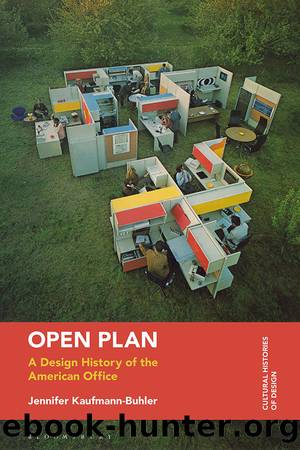Open Plan: A Design History of the American Office by Jennifer Kaufmann-Buhler

Author:Jennifer Kaufmann-Buhler [Kaufmann-Buhler, Jennifer]
Language: eng
Format: epub
ISBN: 9781350044746
Google: 5lwIEAAAQBAJ
Published: 2020-12-10T02:43:33+00:00
Adapting the Workstation
Once the architect or designer finished their work and the organization moved in, the space of the workstation evolved from a standardized template for an imaginary worker into a personal workspace for a real worker. Although the open plan workstation was often designed for a generic position in the organization it was always eventually inhabited by a person. As part of their interaction with the workstation, workers typically had the opportunity to arrange their own working materials within the provided space. Even a standardized workstation with fixed (inflexible) components had interior spaces that offered each worker some opportunity to customize and personalize. The initially empty drawers, bins, wardrobes, and shelves were soon populated with materials and supplies, and work surfaces were quickly covered by the detritus of the working process. The interior compartments of a workstationâs storage elements afforded workers space for containing, organizing, and sorting a variety of objects ranging from common office supplies like pens, pencils, paperclips, pushpins, and staplers to specialized items like computer media and drawing materials. Furniture manufacturers provided a suite of workstation accessories designed to facilitate these various individual needs and enable even quite fixed workstation components to be adapted to different uses and preferences.
The selection and arranging of these organizing things within the working space is itself a design activity. Workers chose which drawers and compartments to use for their working materials, and made decisions on how to organize their files and materials within the workstation. As some likely took pleasure in this process of carefully organizing and arranging the various inner compartments; others perhaps just dumped their things into their drawers without much concern for order. Nonetheless, both options reflect a choice about how those interior components were used. These decisions about how to arrange and use those interior compartments reflects the workerâs unique position and role (the specific things they need to do their job), as well as their individual method of fulfilling that role (the personal way they choose to order materials reflects their usage and their preferences). The drawers and inner spaces were also home to numerous personal items: tampons, makeup, lip balm, brushes or combs, breath mints, umbrellas, extra clothing (a spare set of shoes or a sweater), snacks, tea bags, and even sugar, salt, pepper, and ketchup packets tucked away for future use. The inner life of these workstations was thus very much a reflection of the worker who used it.
In the early 1980s, behavioral consultant Ronald Goodrich conducted a study of several large office buildings to understand how users related to their working environment. In his analysis of individual workspaces, Goodrich identified five distinct criteria that seemed to create marked differences in how workers organized and used their workstations. First, workers who favored visual modes of processing typically had more paper and other physical materials than those who prioritized auditory information. In terms of organization, some workers tended to spread out their work horizontally across multiple work surfaces while others preferred to organize their materials (and their workspace) to accommodate a vertical arrangement.
Download
This site does not store any files on its server. We only index and link to content provided by other sites. Please contact the content providers to delete copyright contents if any and email us, we'll remove relevant links or contents immediately.
Kathy Andrews Collection by Kathy Andrews(11767)
The remains of the day by Kazuo Ishiguro(8895)
Spare by Prince Harry The Duke of Sussex(5142)
Paper Towns by Green John(5141)
The Body: A Guide for Occupants by Bill Bryson(5033)
Industrial Automation from Scratch: A hands-on guide to using sensors, actuators, PLCs, HMIs, and SCADA to automate industrial processes by Olushola Akande(5027)
Machine Learning at Scale with H2O by Gregory Keys | David Whiting(4261)
Be in a Treehouse by Pete Nelson(3999)
Never by Ken Follett(3885)
Harry Potter and the Goblet Of Fire by J.K. Rowling(3810)
Goodbye Paradise(3766)
Into Thin Air by Jon Krakauer(3350)
The Remains of the Day by Kazuo Ishiguro(3348)
Fairy Tale by Stephen King(3309)
The Cellar by Natasha Preston(3299)
The Genius of Japanese Carpentry by Azby Brown(3256)
120 Days of Sodom by Marquis de Sade(3227)
The Man Who Died Twice by Richard Osman(3042)
Drawing Shortcuts: Developing Quick Drawing Skills Using Today's Technology by Leggitt Jim(3040)
